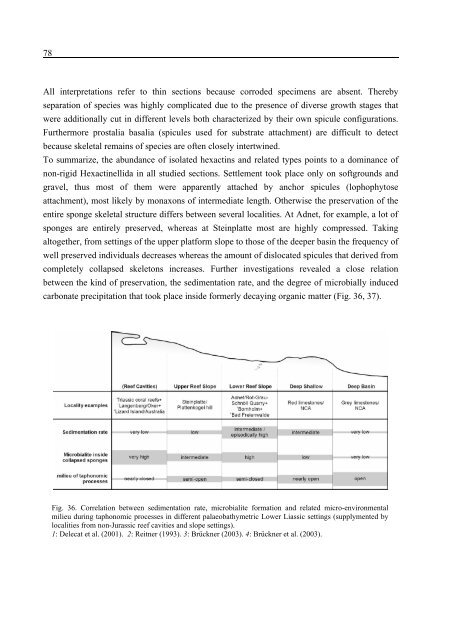Porifera-microbialites of the Lower Liassic (Northern Calcareous ...
Porifera-microbialites of the Lower Liassic (Northern Calcareous ...
Porifera-microbialites of the Lower Liassic (Northern Calcareous ...
Create successful ePaper yourself
Turn your PDF publications into a flip-book with our unique Google optimized e-Paper software.
78<br />
All interpretations refer to thin sections because corroded specimens are absent. Thereby<br />
separation <strong>of</strong> species was highly complicated due to <strong>the</strong> presence <strong>of</strong> diverse growth stages that<br />
were additionally cut in different levels both characterized by <strong>the</strong>ir own spicule configurations.<br />
Fur<strong>the</strong>rmore prostalia basalia (spicules used for substrate attachment) are difficult to detect<br />
because skeletal remains <strong>of</strong> species are <strong>of</strong>ten closely intertwined.<br />
To summarize, <strong>the</strong> abundance <strong>of</strong> isolated hexactins and related types points to a dominance <strong>of</strong><br />
non-rigid Hexactinellida in all studied sections. Settlement took place only on s<strong>of</strong>tgrounds and<br />
gravel, thus most <strong>of</strong> <strong>the</strong>m were apparently attached by anchor spicules (lophophytose<br />
attachment), most likely by monaxons <strong>of</strong> intermediate length. O<strong>the</strong>rwise <strong>the</strong> preservation <strong>of</strong> <strong>the</strong><br />
entire sponge skeletal structure differs between several localities. At Adnet, for example, a lot <strong>of</strong><br />
sponges are entirely preserved, whereas at Steinplatte most are highly compressed. Taking<br />
altoge<strong>the</strong>r, from settings <strong>of</strong> <strong>the</strong> upper platform slope to those <strong>of</strong> <strong>the</strong> deeper basin <strong>the</strong> frequency <strong>of</strong><br />
well preserved individuals decreases whereas <strong>the</strong> amount <strong>of</strong> dislocated spicules that derived from<br />
completely collapsed skeletons increases. Fur<strong>the</strong>r investigations revealed a close relation<br />
between <strong>the</strong> kind <strong>of</strong> preservation, <strong>the</strong> sedimentation rate, and <strong>the</strong> degree <strong>of</strong> microbially induced<br />
carbonate precipitation that took place inside formerly decaying organic matter (Fig. 36, 37).<br />
Fig. 36. Correlation between sedimentation rate, microbialite formation and related micro-environmental<br />
milieu during taphonomic processes in different palaeobathymetric <strong>Lower</strong> <strong>Liassic</strong> settings (supplymented by<br />
localities from non-Jurassic reef cavities and slope settings).<br />
1: Delecat et al. (2001). 2: Reitner (1993). 3: Brückner (2003). 4: Brückner et al. (2003).

















